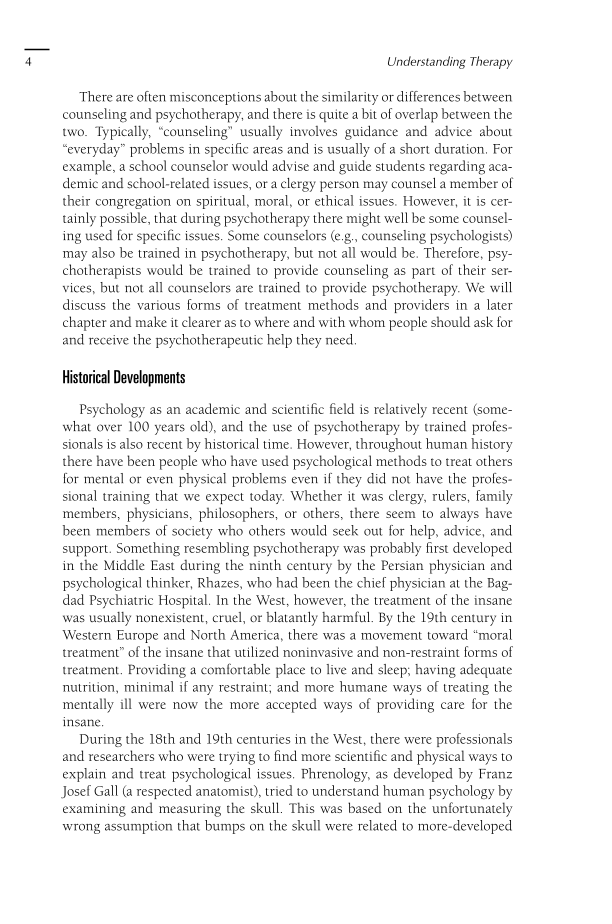4 Understanding Therapy There are often misconceptions about the similarity or differences between counseling and psychotherapy, and there is quite a bit of overlap between the two. Typically, “counseling” usually involves guidance and advice about “everyday” problems in specifi c areas and is usually of a short duration. For example, a school counselor would advise and guide students regarding aca- demic and school-related issues, or a clergy person may counsel a member of their congregation on spiritual, moral, or ethical issues. However, it is cer- tainly possible, that during psychotherapy there might well be some counsel- ing used for specifi c issues. Some counselors (e.g., counseling psychologists) may also be trained in psychotherapy, but not all would be. Therefore, psy- chotherapists would be trained to provide counseling as part of their ser- vices, but not all counselors are trained to provide psychotherapy. We will discuss the various forms of treatment methods and providers in a later chapter and make it clearer as to where and with whom people should ask for and receive the psychotherapeutic help they need. Historical Developments Psychology as an academic and scientifi c fi eld is relatively recent (some- what over 100 years old), and the use of psychotherapy by trained profes- sionals is also recent by historical time. However, throughout human history there have been people who have used psychological methods to treat others for mental or even physical problems even if they did not have the profes- sional training that we expect today. Whether it was clergy, rulers, family members, physicians, philosophers, or others, there seem to always have been members of society who others would seek out for help, advice, and support. Something resembling psychotherapy was probably fi rst developed in the Middle East during the ninth century by the Persian physician and psychological thinker, Rhazes, who had been the chief physician at the Bag- dad Psychiatric Hospital. In the West, however, the treatment of the insane was usually nonexistent, cruel, or blatantly harmful. By the 19th century in Western Europe and North America, there was a movement toward “moral treatment” of the insane that utilized noninvasive and non-restraint forms of treatment. Providing a comfortable place to live and sleep having adequate nutrition, minimal if any restraint and more humane ways of treating the mentally ill were now the more accepted ways of providing care for the insane. During the 18th and 19th centuries in the West, there were professionals and researchers who were trying to fi nd more scientifi c and physical ways to explain and treat psychological issues. Phrenology, as developed by Franz Josef Gall (a respected anatomist), tried to understand human psychology by examining and measuring the skull. This was based on the unfortunately wrong assumption that bumps on the skull were related to more-developed
Document Details My Account Print multiple pages
Print
You have printed 0 times in the last 24 hours.
Your print count will reset on at .
You may print 0 more time(s) before then.
You may print a maximum of 0 pages at a time.


























































































































































































































































